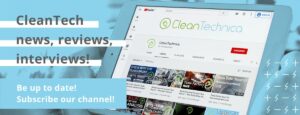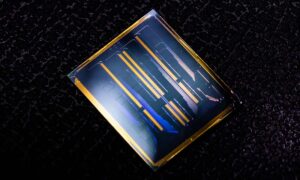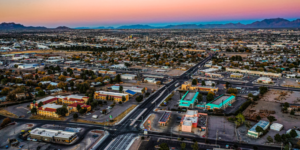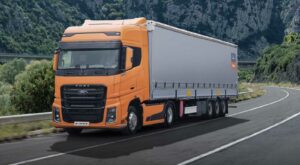The diesel engine is dead. It just doesn’t know it yet. In Europe, people actually ride buses and enjoy them. Americans would rather stick a fork in their eye than ride a bus. It’s a cultural thing; don’t ask. MAN, the heavy vehicle arm of Volkswagen Group, has made an executive decision not to manufacture diesel-powered buses that comply with the upcoming Euro 7 exhaust emissions rules. It will focus on battery-electric buses instead. Daimler Truck also is in the bus business. It too will add more electric buses to its lineup, but they feature a hydrogen fuel cell range extender. Here’s more.
MAN Introduces New Electric Buses
If you are into buses, you are in beautiful Barcelona this week for the UITP Global Public Transport Summit, where officials from all over the world are salivating over the latest in public transportation vehicles. MAN is using the occasion to introduce its Lion’s City 10, a derivative of its popular Lion’s City 12 electric buses that have been in production for two years.
The Lion’s City 10 is focused on the rising interest in on-demand services. In a press release, the company says, “In this era of the transport revolution and increasing use of customer oriented on demand services, the days of ‘one size fits all’ are long gone for sure. Midi buses of less than 12 meters in length are set to play an increasingly important role in the future. They have a passenger capacity similar to that on the 12-meter solo buses while taking up significantly less space in narrow city centers and depots.
“They are also far nippier. As well as on-demand services, these compact types are often used as replacement vehicles during peak hours. Fully electric, locally emissions free buses such as the Lion’s City 10 E were made with precisely this purpose in mind.”
It’s not often we see the word “nippier” in a press release for buses, electric or otherwise, but MAN is quite proud that its new bus has a turning circle of just 17.5 meters, which allows it to go zipping around cities like a Formula E racer, apparently. The new bus rides on a 4.4-meter wheelbase — 1.6 meters less than the Lion’s City 12. Yet it carries more passengers than diesel-powered buses of the same length because there is no diesel stack mounted in the rear, which permits the addition of more seats.
The NMC batteries for the Lion’s City 10 — either 320 kWh or 400 kWh — are mounted on the roof, leaving more room inside for passengers. With the smaller battery pack, the buses have a range of 235 km, which increases to 300 km with the larger pack. The new buses will have a semi-autonomous driving capability, thanks to a onboard navigation system supplied by Mobileye.
No Diesel Buses For You!
https://media.daimlertruck.com/marsMediaSite/en/instance/ko/Mercedes-Benz-at-the-2023-Global-Public-Transport-Summit-eCitaro-fuel-cell-series-production-ramp-up.xhtml
” data-image-caption=”
Courtesy of Daimler Truck
” data-medium-file=”https://platoaistream.com/wp-content/uploads/2023/06/man-goes-all-in-on-electric-buses-daimler-introduces-fuel-cell-ecitaro-cleantechnica-1.jpg” data-large-file=”https://platoaistream.com/wp-content/uploads/2023/06/man-goes-all-in-on-electric-buses-daimler-introduces-fuel-cell-ecitaro-cleantechnica-2.jpg” decoding=”async” loading=”lazy” class=”size-full wp-image-297480″ src=”https://platoaistream.com/wp-content/uploads/2023/06/man-goes-all-in-on-electric-buses-daimler-introduces-fuel-cell-ecitaro-cleantechnica.jpg” alt=”Daimler electric bus” width=”888″ height=”444″ srcset=”https://platoaistream.com/wp-content/uploads/2023/06/man-goes-all-in-on-electric-buses-daimler-introduces-fuel-cell-ecitaro-cleantechnica.jpg 888w, https://platoaistream.com/wp-content/uploads/2023/06/man-goes-all-in-on-electric-buses-daimler-introduces-fuel-cell-ecitaro-cleantechnica-1.jpg 400w, https://platoaistream.com/wp-content/uploads/2023/06/man-goes-all-in-on-electric-buses-daimler-introduces-fuel-cell-ecitaro-cleantechnica-2.jpg 800w, https://cleantechnica.com/files/2023/06/Daimler-fuel-cell-articulated-bus-768×384.jpg 768w” sizes=”(max-width: 888px) 100vw, 888px”>
Image courtesy of Daimler Truck
Last fall, the EU Commission proposed new emission limits for Euro 7, which would apply to buses and trucks over 3.5 tons. In order to meet the new standard, manufacturers would need to divert technical and financial resources away from developing zero emissions vehicles. MAN has decided it won’t continue to manufacture diesel-powered buses for sale in Europe after the new emissions rules take effect.
“In 2030 we will not sell any combustion engine city bus in Europe,” said Heinz Kiess, head of product marketing for MAN Truck and Bus. “Looking at the evolution of the city bus market in Europe, we don’t see gas drivetrains to have a market in the future. We see room for fuel cell buses but no more than 10 per cent of the bus market.”
Daimler Truck, which manufactures buses as well, has also said it will convert all its products for European customers to electricity by 2030, but some of them will have hydrogen fuel cells on board to boost range. At the Barcelona show this week, the company showcased its eCitaro Fuel Cell bus. The 60 kW fuel cell gives the vehicle the ability to drive longer distances without recharging along the way. The solo bus can go up to 400 km while the articulated model has a range of 350 km.
As a solo bus, the model has three NMC battery packs with a combined capacity of 294 kWh. As an articulated bus, there are three or four packs with a cumulative capacity of up to 392 kWh. In both cases, the fuel cell has an output of 60 kW and is supplied by Toyota. Both the battery packs and the fuel cell, which weighs 240 kg, are mounted on the roof along with up to 7 high pressure tanks that can store a maximum of 35 kg of hydrogen.
Daimler acknowledges that electricity to recharge the batteries is less expensive than hydrogen — at least today – and that is why the fuel cell is intended to be used a range extender rather than as a primary power source. When it comes to refilling the hydrogen tanks, the company says, “Under optimum conditions and depending on the refueling infrastructure, the refueling time in the solo bus is around ten minutes.” The fuel cell has a service life of 40,000 hours, equivalent to 7 to 10 years of use.
Coordinating how much power is supplied by the batteries and how much is supplied by the fuel cell is carefully regulated by an intelligent control system that allows operators to choose between two different operating modes.
In the “maximum range” mode, both the battery and the hydrogen fuel cell are utilized to the maximum. In the “Minimum H2 consumption” mode, the battery supplies the majority of the energy for the drive and auxiliary systems such as heat and air conditioning while the fuel cell only supplies as much energy as is necessary to achieve the previously set range.
The range extender solo bus uses the same ZF drive axle fitted to its non-fuel cell eCitaro buses. It produces 125 kW of power and 485 Nm of torque. The articulated bus uses two electric axles with a rated power 125 kW each.
The Takeaway
The message here is that two of Europe’s primary bus manufacturers have decided that investing in improved diesel engines is not a wise use of resources. Even though the diesel engine has been the workhorse of heavy duty transportation for many years, its exhaust emissions are simply more of a burden than society can tolerate. The Earth will heave a sigh of relief as more electric buses take over the public transportation chores currently served by diesel buses.
Sign up for daily news updates from CleanTechnica on email. Or follow us on Google News!
Have a tip for CleanTechnica, want to advertise, or want to suggest a guest for our CleanTech Talk podcast? Contact us here.
Former Tesla Battery Expert Leading Lyten Into New Lithium-Sulfur Battery Era — Podcast:
I don’t like paywalls. You don’t like paywalls. Who likes paywalls? Here at CleanTechnica, we implemented a limited paywall for a while, but it always felt wrong — and it was always tough to decide what we should put behind there. In theory, your most exclusive and best content goes behind a paywall. But then fewer people read it! We just don’t like paywalls, and so we’ve decided to ditch ours. Unfortunately, the media business is still a tough, cut-throat business with tiny margins. It’s a never-ending Olympic challenge to stay above water or even perhaps — gasp — grow. So …
Advertisement
- SEO Powered Content & PR Distribution. Get Amplified Today.
- PlatoAiStream. Web3 Data Intelligence. Knowledge Amplified. Access Here.
- Minting the Future w Adryenn Ashley. Access Here.
- Buy and Sell Shares in PRE-IPO Companies with PREIPO®. Access Here.
- Source: https://cleantechnica.com/2023/06/05/man-goes-all-in-on-electric-buses-daimler-introduces-fuel-cell-ecitaro/
- :has
- :is
- :not
- :where
- $UP
- 000
- 1
- 10
- 12
- 17
- 2030
- 320
- 40
- 60
- 7
- 9
- a
- ability
- above
- Achieve
- actually
- add
- addition
- Advertise
- After
- AIR
- Air Conditioning
- All
- allows
- along
- also
- always
- Americans
- an
- and
- any
- Apply
- ARE
- ARM
- around
- AS
- At
- away
- barcelona
- batteries
- battery
- BE
- beautiful
- because
- been
- behind
- BEST
- between
- Bit
- board
- boost
- both
- burden
- bus
- Buses
- business
- but
- by
- CAN
- Capacity
- carefully
- cases
- Cells
- Centers
- challenge
- chip
- Choose
- Circle
- Cities
- City
- cleantech
- Cleantech Talk
- combined
- comes
- commission
- company
- conditions
- content
- continue
- control
- convert
- cultural
- Currently
- customer
- Customers
- Daimler
- Days
- dead
- decide
- decided
- decision
- Demand
- Depending
- derivative
- diesel
- different
- do
- Doesn’t
- don
- Dont
- drive
- driving
- during
- e
- each
- earth
- effect
- either
- Electric
- electricity
- emission
- Emissions
- energy
- Engine
- Engines
- enjoy
- Equivalent
- Era
- Ether (ETH)
- EU
- Euro
- Europe
- European
- Europes
- Even
- evolution
- Exclusive
- executive
- expensive
- expert
- eye
- Fall
- far
- Feature
- fewer
- financial
- Focus
- focused
- For
- fork
- formula
- four
- Free
- from
- Fuel
- fuel cells
- fully
- future
- GAS
- gives
- Global
- Go
- Goes
- gone
- Group
- Grow
- Guest
- Have
- head
- heavy
- help
- here
- High
- HOURS
- How
- HTTPS
- hydrogen
- Hydrogen Fuel
- if
- implemented
- important
- improved
- in
- Increases
- increasing
- increasingly
- Infrastructure
- instead
- Intelligent
- intended
- interest
- into
- introduce
- Introduces
- investing
- IT
- ITS
- jpg
- just
- Know
- larger
- latest
- leading
- least
- leaving
- Length
- less
- Life
- like
- Limited
- limits
- lineup
- locally
- Long
- longer
- made
- Majority
- man
- Manufacturers
- many
- margins
- Market
- Marketing
- max-width
- maximum
- Media
- Meet
- message
- mind
- minutes
- Mobileye
- Mode
- model
- modes
- monthly
- more
- most
- much
- Navigation
- necessary
- Need
- New
- news
- no
- occasion
- of
- officials
- often
- Olympic
- on
- On-Demand
- on-demand services
- Onboard
- only
- operating
- operators
- optimum
- or
- order
- otherwise
- our
- output
- over
- Pack
- Packs
- Patreon
- PayPal
- Peak
- People
- perhaps
- plato
- Plato Data Intelligence
- PlatoData
- Play
- please
- podcast
- Popular
- power
- precisely
- press
- Press Release
- pressure
- previously
- primary
- Product
- Production
- Products
- proposed
- proud
- public
- public transportation
- purpose
- put
- range
- rated
- rather
- Read
- Recharge
- Refueling
- regulated
- release
- relief
- replacement
- Resources
- Revolution
- Ride
- rising
- Role
- roof
- Room
- rules
- s
- Said
- sale
- same
- says
- see
- sell
- service
- Services
- set
- should
- show
- showcased
- significantly
- similar
- simply
- Size
- smaller
- So
- Society
- some
- Source
- Space
- stack
- standard
- stay
- Stick
- Still
- store
- such
- suggest
- supplied
- support
- system
- Systems
- Take
- taking
- Talk
- Tanks
- team
- Technical
- ten
- Tesla
- than
- thanks
- that
- The
- The Future
- the world
- their
- Them
- then
- theory
- There.
- These
- they
- thing
- this
- this week
- though?
- three
- time
- tip
- to
- today
- tons
- too
- tough
- toyota
- transport
- transportation
- truck
- Trucks
- Turning
- two
- types
- upcoming
- Updates
- us
- use
- used
- uses
- using
- utilized
- Ve
- vehicle
- Vehicles
- via
- volkswagen
- Volkswagen Group
- want
- was
- Water
- Way..
- we
- week
- weighs
- WELL
- were
- What
- when
- which
- while
- WHO
- why
- will
- WISE
- with
- without
- Word
- world
- would
- Wrong
- years
- yet
- you
- Your
- zephyrnet
- zero








